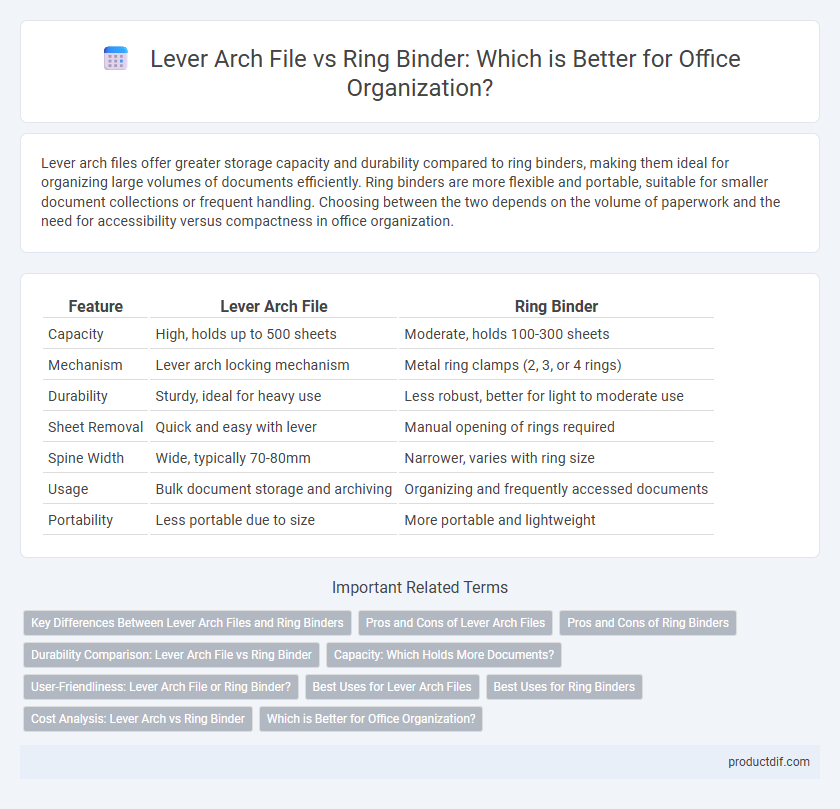Lever arch files offer greater storage capacity and durability compared to ring binders, making them ideal for organizing large volumes of documents efficiently. Ring binders are more flexible and portable, suitable for smaller document collections or frequent handling. Choosing between the two depends on the volume of paperwork and the need for accessibility versus compactness in office organization.
Table of Comparison
| Feature | Lever Arch File | Ring Binder |
|---|---|---|
| Capacity | High, holds up to 500 sheets | Moderate, holds 100-300 sheets |
| Mechanism | Lever arch locking mechanism | Metal ring clamps (2, 3, or 4 rings) |
| Durability | Sturdy, ideal for heavy use | Less robust, better for light to moderate use |
| Sheet Removal | Quick and easy with lever | Manual opening of rings required |
| Spine Width | Wide, typically 70-80mm | Narrower, varies with ring size |
| Usage | Bulk document storage and archiving | Organizing and frequently accessed documents |
| Portability | Less portable due to size | More portable and lightweight |
Key Differences Between Lever Arch Files and Ring Binders
Lever arch files feature a robust lever mechanism allowing easy opening and closing of large capacity metal rings, designed to hold up to 500 sheets securely. Ring binders typically use a simpler circular or D-shaped ring system, ideal for lighter document storage with capacities ranging from 100 to 300 sheets. Lever arch files offer superior durability and bulk storage for heavy-duty filing, while ring binders provide greater flexibility and ease of use for frequently accessed documents.
Pros and Cons of Lever Arch Files
Lever arch files feature a robust locking mechanism that secures large volumes of documents, making them ideal for extensive filing needs. Their durable spine and wide capacity allow easy organization and retrieval, although they tend to be bulkier and less flexible than ring binders. While ring binders offer lighter weight and versatility for smaller collections, lever arch files excel in stability and long-term storage, making them essential for heavy-duty office filing systems.
Pros and Cons of Ring Binders
Ring binders offer superior flexibility in adding or removing pages, making them ideal for frequently updated documents and customizable organization systems. They come in various capacities and sizes, but may provide less structural support compared to lever arch files, which can impact durability for heavy documents. Their standard three-ring mechanism ensures compatibility with most hole-punched papers, though pages can potentially loosen if the rings are not properly aligned or closed.
Durability Comparison: Lever Arch File vs Ring Binder
Lever arch files feature robust metal mechanisms and thicker covers, providing superior durability compared to typical ring binders, which often have thinner covers and lighter metal rings. The reinforced spine and heavy-duty lever of arch files ensure they withstand frequent use and heavy document loads without bending or breaking. Ring binders may succumb to ring deformation and cover wear over time, making lever arch files a more reliable choice for long-term document storage.
Capacity: Which Holds More Documents?
Lever arch files typically hold more documents than ring binders, with a capacity of up to 500 sheets compared to the 200 to 300 sheets usually held by ring binders. The lever arch mechanism allows for a wider spine and stronger compression, making it ideal for bulkier document storage. Ring binders, while convenient for smaller volumes, do not offer the same capacity and stability as lever arch files for heavy filing needs.
User-Friendliness: Lever Arch File or Ring Binder?
Lever arch files offer superior user-friendliness due to their easy-to-operate lever mechanism, allowing quick opening and closing without effort, ideal for frequent document access. Ring binders provide flexibility with multiple ring sizes and configurations but require more manual dexterity to open and close, which can be less convenient for rapid use. Users seeking efficiency prefer lever arch files for their robust design and ease of handling in busy office environments.
Best Uses for Lever Arch Files
Lever arch files excel at storing large volumes of documents, making them ideal for office environments that require frequent access to extensive paperwork. Their sturdy spine and locking mechanism ensure secure organization and easy retrieval, especially suited for archiving reports, contracts, and financial records. Compared to ring binders, lever arch files provide greater durability and capacity, supporting efficient document management in corporate settings.
Best Uses for Ring Binders
Ring binders are ideal for organizing documents that require frequent updating or removal, such as project files, presentations, and reports. Their flexibility allows easy addition or rearrangement of pages without damaging the holes, making them perfect for dynamic workflows. Commonly used in offices, schools, and home environments, ring binders support various paper sizes and accessories like dividers and pockets for enhanced customization.
Cost Analysis: Lever Arch vs Ring Binder
Lever arch files typically cost more upfront than ring binders due to their robust metal mechanisms and larger storage capacity, making them ideal for heavy document management. Ring binders, available at lower prices, offer cost efficiency for lighter use and smaller volumes, but may require more frequent replacement. Evaluating long-term value involves weighing lever arch durability against the affordability and versatility of ring binders in office supply budgeting.
Which is Better for Office Organization?
Lever arch files offer superior capacity and durability for storing large volumes of documents, making them ideal for intensive office organization. Ring binders provide flexibility with customizable ring sizes and easy document removal, suitable for frequently accessed files. Choosing between the two depends on the volume and frequency of document handling in the office environment.
Lever arch file vs Ring binder Infographic

 productdif.com
productdif.com